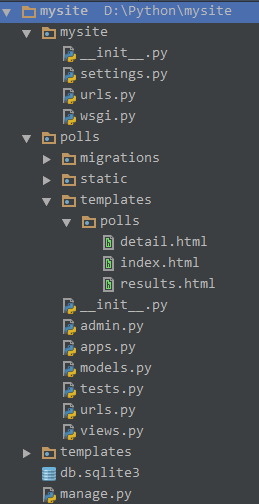主要参考官方文档
Windows 10
Python 23.5
Django 1.9
1.创建项目(mysite)与应用(polls)
D:\python>django-admin.py startproject mysite
D:\python>cd mysite
D:\python\mysite>python manage.py startapp polls

创建app后将app加入到setting中,打开mysite/setting.py,将polls这个应用添加进去
INSTALLED_APPS = [ 'polls.apps.PollsConfig', 'django.contrib.admin', 'django.contrib.auth', 'django.contrib.contenttypes', 'django.contrib.sessions', 'django.contrib.messages', 'django.contrib.staticfiles', ]
2.创建模型
打开polls/models.py
import datetime from django.db import models from django.utils.encoding import python_2_unicode_compatible from django.utils import timezone # Create your models here. # 问题 @python_2_unicode_compatible class Question(models.Model): question_text = models.CharField(max_length=200) pub_date = models.DateTimeField('date published') def was_published_recently(self): now = timezone.now() return timezone.now()-datetime.timedelta(days=1) <= self.pub_date <= now was_published_recently.admin_order_field = 'pub_date' was_published_recently.boolean = True was_published_recently.short_description = 'Published recently?' def __str__(self): return self.question_text # 选择 @python_2_unicode_compatible class Choice(models.Model): question = models.ForeignKey(Question, on_delete = models.CASCADE) choice_text = models.CharField(max_length=200) votes = models.IntegerField(default=0) def __str__(self): return self.choice_text
运行命令:python manage.py makemigrations 和python manage.py migrate全数据库生成相应的表
3.后台管理
打开polls/admin.py,
from django.contrib import admin from .models import Question, Choice # Register your models here. class ChoiceInline(admin.TabularInline): model = Choice extra = 3 class QuestionAdmin(admin.ModelAdmin): fieldsets = [ (None, {'fields': ['question_text']}), ('Date information', {'fields': ['pub_date']}), ] inlines = [ChoiceInline] list_filter = ['pub_date'] list_display = ('question_text', 'pub_date', 'was_published_recently') search_fields = ['question_text'] admin.site.register(Question, QuestionAdmin)
4.编写视图函数(展示)
from django.shortcuts import render, get_object_or_404 from django.http import HttpResponseRedirect, Http404 from .models import Question, Choice from django.core.urlresolvers import reverse from django.views import generic from django.utils import timezone # Create your views here. # 展示所有问题 class IndexView(generic.ListView): template_name = 'polls/index.html' context_object_name = 'latest_question_list' def get_queryset(self): #return the last five published question return Question.objects.filter(pub_date__lte = timezone.now()).order_by('-pub_date')[:5] # 查看问题详情 class DetailView(generic.DetailView): model = Question template_name = 'polls/detail.html' def get_queryset(self): """ Excludes any questions that aren't published yet. """ return Question.objects.filter(pub_date__lte=timezone.now()) # 查看结果 class ResultsView(generic.DeleteView): model = Question template_name = 'polls/detail.html' # 投票 def vote(request, question_id): question = get_object_or_404(Question, pk=question_id) try: selected_choice = question.choice_set.get(pk=request.POST['choice']) except (KeyError, Choice.DoesNotExist): # Redisplay the question voting form. return render(request, 'polls/detail.html', {'question': question, 'error_message': "You didn't select a choice.",}) else: selected_choice.votes += 1 selected_choice.save() # Always return an HttpResponseRedirect after successfully dealing # with POST data. This prevents data from being posted twice if a # user hits the Back button. return HttpResponseRedirect(reverse('polls:results', args=(question.id,)))
5.模板
视图函数处理的结果通过模板展示出来
detail.html
<h1>{{ question.question_text }}</h1> {% if error_message %}<p><strong>{{ error_message }}</strong></p>{% endif %} <form action="{% url 'polls:vote' question.id %}" method="post"> {% csrf_token %} {% for choice in question.choice_set.all %} <input type="radio" name="choice" id="choice{{ forloop.counter }}" value="{{ choice.id }}" /> <label for="choice{{ forloop.counter }}">{{ choice.choice_text }}</label><br /> {% endfor %} <input type="submit" value="Vote" /> </form>
index.html
{% if latest_question_list %} <ul> {% for question in latest_question_list %} <li><a href="/polls/{{ question.id }}/">{{ question.question_text }}</a></li> {% endfor %} </ul> {% else %} <p>No polls are available.</p> {% endif %}
results.html
<h1>{{ question.question_text }}</h1> <ul> {% for choice in question.choice_set.all %} <li>{{ choice.choice_text }} -- {{ choice.votes }} vote{{ choice.votes|pluralize }}</li> {% endfor %} </ul> <a href="{% url 'polls:detail' question.id %}">Vote again?</a>
6.url分发
不同的url在这里进行分发到不同的函数处理
mysite/urls.py
from django.conf.urls import url, include from django.contrib import admin urlpatterns = [ url(r'^polls/', include('polls.urls')), url(r'^admin/', admin.site.urls), ]
再次分发
polls/urls.py
#coding:utf-8 #!/usr/bin/env python from django.conf.urls import url from . import views app_name = 'polls' urlpatterns = [ # ex: /polls/ url(r'^$', views.IndexView.as_view(), name='index'), # ex: /polls/5/ url(r'^(?P<pk>[0-9]+)/$', views.DetailView.as_view(), name='detail'), # /polls/5/results/ url(r'^(?P<pk>[0-9]+)/results/$', views.ResultsView.as_view(), name='results'), # /polls/5/vote/ url(r'^(?P<question_id>[0-9]+)/vote/$', views.vote, name='vote'), ]
输入命令python manage.py runserver,运行系统
登陆后:


不登陆,可以查看到相应的问题,选中相应的小圆点,点击vote可进行投票。


